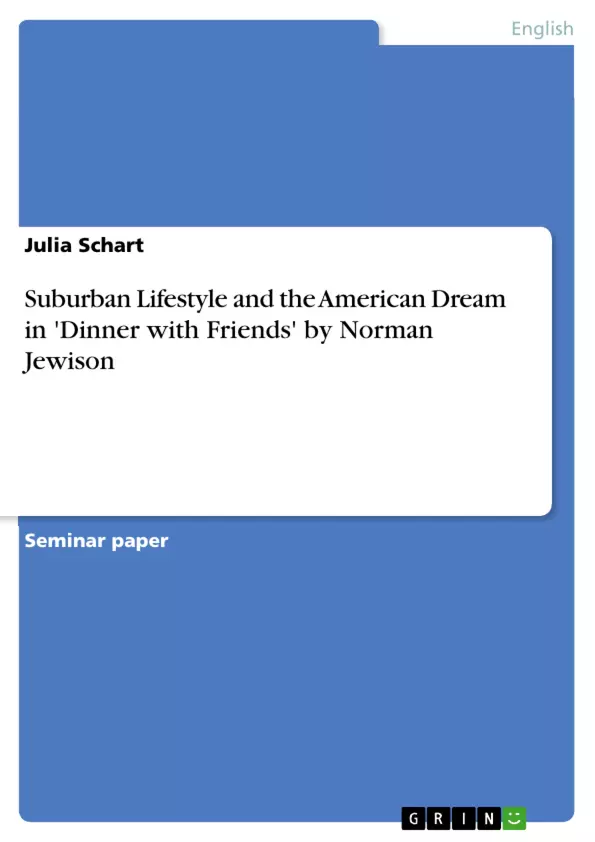The thesis is about the film drama “Dinner with Friends” by Norman Jewison. In that contemporary drama “Dinner with Friends”, written in 2000 by the author Donald Margulies, and in the following filmic adaptation one year later by Norman Jewison, the two modern families show that reviving the ideal of the traditional postwar suburban nuclear family of the 1950s as well as falling apart can still mean the fulfillment of the American Dream as a peak target in life.
In “Dinner with Friends”, the situation of going through divorce and finding a new personal orientation in life is depicted by the couple Tom and Beth. In contrast to that, the other couple Gabe and Karen depict the opposite way of living together, which is the convinced will of maintaining the traditional suburban values of loyalty, love, intensive care and honoring each other. Inspite of changing moral concepts among the society of the 21st century, in many heads the latter attributes still represent the prototypical ideal of a perfect family. Nevertheless, this does not mean that any of those two ways is better than the other one, the only secret is just that they are both differently realized.
Inhaltsverzeichnis (Table of Contents)
- Introduction
- The American Dream and the problem of the postwar suburbs of the 1950s.
- Gabe and Karen respresenting the traditional values of perfectness
- Suburban family ideals in modern times.
- Tom and Beth representing a model of modern family life.
- Conclusion
- List of works cited...
Zielsetzung und Themenschwerpunkte (Objectives and Key Themes)
The text explores the evolving concept of the American Dream and its relationship to the suburban family model, using the play "Dinner with Friends" by Donald Margulies as a case study. The text analyzes the portrayal of two couples, Gabe and Karen, who represent traditional suburban values, and Tom and Beth, who embody a more modern approach to family life.
- The American Dream and its connection to suburban living
- The evolving definition of "family" and traditional family ideals
- The changing roles of women in society
- The portrayal of suburban life in modern times
- The impact of divorce on families
Zusammenfassung der Kapitel (Chapter Summaries)
- Introduction: The text begins by introducing the central theme of family and its evolution, referencing Richard Bach's quote on the nature of family. The author then discusses the significance of "Dinner with Friends" in depicting the complexities of modern families and their relationship with the American Dream.
- The American Dream and the problem of the postwar suburbs of the 1950s.: This chapter explores the origins and evolution of the American Dream, tracing it back to the "Declaration of Independence" and the ideals of "life, liberty, and the pursuit of happiness." The chapter then examines the specific impact of the post-World War II era on the American Dream, focusing on the rise of suburban living and the idealized picture of the nuclear family.
- Gabe and Karen respresenting the traditional values of perfectness: This chapter delves into the portrayal of Gabe and Karen in "Dinner with Friends," highlighting how their adherence to traditional suburban values reflects the idealized image of the postwar nuclear family. The chapter analyzes their lifestyle, emphasizing their dedication to homemaking, cooking, and professional success.
Schlüsselwörter (Keywords)
The primary focus of the text is on the American Dream, suburban family life, and the evolving nature of family values. Key concepts include the traditional postwar nuclear family model, the changing roles of women in society, divorce, and modern family dynamics. The text draws on examples from the play "Dinner with Friends" and the works of authors such as Betty Friedan, highlighting the impact of societal changes on individual experiences and aspirations.
- Citation du texte
- Julia Schart (Auteur), 2013, Suburban Lifestyle and the American Dream in 'Dinner with Friends' by Norman Jewison, Munich, GRIN Verlag, https://www.grin.com/document/503005



